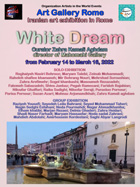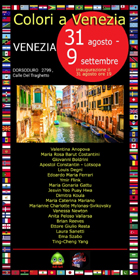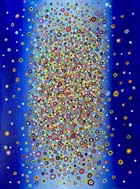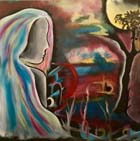Biography of Giuseppe Barsciglie'
 BYOGRAPHY-CURRICULUM
BYOGRAPHY-CURRICULUMBorn in Torre del Greco on 05/05/1951
He lived in Sorrento(near Naples)since 1951
He have three qualifications to teaching in schools of order and superior degree.
He has undertaken the scholastic career from 1972/1973 to today.
In possession of following titles:
• diploma of degree in Painting in the Academy of Naples -1973
• diploma of Architecture (graduation thesis on urban furnishings project) 110/110- 1979 Rome
• qualification to the teaching of advertising graphics and photography -1974
• qualification to the teaching of ornamental plastic disciplines - 1979
• qualification to the teaching of pictorial disciplines – 2002
Offices done:
• Start to practice the arts of the plastic techniques in the fusions and new technical of the art contemporary. in Padova and Turin on 1970
• He teaches with contemporary sculptors - fusion of the metals - for you furnish industrial in Turin during 1971
• Teacher from young (to today's day) works pictorial plastics with use of oils, plasters, hill and chemical fusions, with the greatest exponents of the pictorial plastic period, creating a particular artistic tide (studies from Butters to Picasso)
• He is present in the classifications of worth to Headmaster entrusted of Institutes of Superior Education since 1990
• He is present in the managerial scholasticisms classifications in Tuscany
• He is present in the classifications of technical management for the Services (secondary schools - sector sciences of the communications) to the Office of Lazio
• Selective member on regional artistic groups for the human rights M.P.I. Regione Toscana U.N.E.S.C.O.
• Selective member on regional artistic groups for the human rights M.P.I. Regione Toscana and Lazio U.N.I.C.E.F. for the north Africa
• Selective member of the regional group of job for the human rights M.P.I. Regione Toscana T.E.L.E.T.O.N.
• Commissioner of examinations of maturity from 1994 to 2000 in many regions of Italy
• President of the first errand of examination for the industrial maturity. Grosseto 2006.
• Teacher in courses of updating and formation of national level
• Teacher of “Pedagogic Montessorian Aspects of the scholastic and institutional normative on the integration” and of "Primary and Secondary Legislation in the progress of support to the handicap"
• Founder and Coordinator of the group “Omnia educational 2005”
• Teacher and tutor selective assignment of the teachers of role of the Office of the Public education in Tuscany
• Member of numerous committees and errands of national and regional level
• Didactic coordinator for the formation of the students in the professional areas (1986-2003)
• Coordinator for the scientific and artistic teaching and cultural activity
• Today he tries a twin ship with the project LUDICA (an university astrophysical observatory in Florence.)and he is professor Pace’s collaborator(teacher of astronomy and Physic
MORE IMPORTANT PUBBLICATIONS
• Works, in about ten volumes, of technical matter, historical, artistic, humanistic, poetic, intercultural;
• Many articles published on various magazines of Italian, Spanish, American and French art;
• Publishing Contributor and responsible of "The Notebooks of Art and Culture of the Gaveer" of which has been administrator together with the Ajuntamento de Cultura of Barcelona, Spain, 2000/2001 and in France
• Many collaborations to the culture and art column of the newspapers “La Repubblica” and “ Il mattino”, “Il resto del Carlino”, “Roma” and “La Nazione” since 1975.
ARTISTIC BIOGRAPHY
Since he where a child ,Giuseppe Barscigliè manifests a big predisposition to drowning and colouring. He attends father Raffaele’s study of Art, painter and sculptor since 1933, sent in war to Cefalonia as King’s Official decorated with white cross of military order of Knights of Malta. After the imprisonment in the nazi fields in Polonia ,Raffaele Barscigliè returns to Naples and he becomes Eduardo De Filippo‘s official scene painter, until 1973.
The young son Giuseppe Barscigliè enrols in the Academy of Fine Arts of Naples attending the courses of set designing and painting. Then he completes and perfects its artistic formation through ateliers and artistic workshops of many painters and sculptors of the Neapolitan and roman schools, father’s friends, and through a lot of presences in the contemporary canters of art. Since 1969 the young artist Giuseppe Barscigliè learns the technique of fresco that adapted its expressive needs. At the same time he always interested to the primordial techniques of the painting of roman age. In the 1972 he moves himself for a period to Rome and Urbino, where he attends the faculty of architecture.
Since 1974 he begins a numerous series of collective exhibitions promoted from the Forni Gallery of Bologna. He holds its first personal exhibition at London in 1979, having much critic and market happening. In the Seventies he increases his expositive activity and he meets in Bruxelles the merchant Guimiot, with which Barscigliè starts an artistic collaboration, realizing many exhibitions in Belgium. During the Eighties and Nineties he exposes his paintings in Italy and in Europe meeting with interest of the critic. In London and in Italy he begins with other young people a new and intense artistic busyness and he orients himself towards a formal renewal based on the experiences of the Italian abstract painting.In 1981 he completes a trip in Spain that pushes him to the reflection on a series of topics and arguments belonged to the history of the Country: travels, conquests, violences, that will influence all its future jobs of painting and sculpture, activity that the artist begins from 1976 with the realization of great plastic and ferrous groups.He realizes numerous public works for the Education National. Since 1977 he enter in the Visconti Gallery of Paris for its first personal showes. In 1978 he prepares a show to Paris and Tokio, and then he mounts other personal exposures to Geneva, Marseilles, Rome, Bologna. Between its international public exposures are remembered: the FIAC of Paris of 1994, the Biennial exhibition of Mientone in 1980, the Biennial exhibition of Vienna 1981 and at last the Biennial exhibition of Saint Paulo in Brasil in 1981.
In 1984 he participates to the exposure "The image and his double" at Milan. During the Eighties its painting becomes almost “iper-realist”, getting origin from artistic language of Tommasi Feroni.In the meantime Barscigliè participates with success in numerous national and international prizes getting considerable recognitions. In 1974 he exposes at Gallery Sant'andrea in Savona and the year later he is to town hall of Millesimo. In 1976 he exposes his works to Valenza.
Beginning from halves of the seventies numerous personal shows are followed in prestigious galleries of art national and foreign, such as 32 Gallery of Milan, Gallery Davico of Turin,Madison Gallery of Toronto,Rayuela Gallery of Madrid, Lev Gallery of Hamburg, Gallery Pelaires of Palm of Mallorca, with catalogues introduced by important critics such as De Micheli and Fagiolo dell’Arco.
Its shares must also be remembered to the National Biennal exhibitions of art in Milan in 1989 and in 1993.From 1980 to 1997 he doesn't miss to the De Nittis prize of Bari and Foggia.
During the mythical year 1969 he is invited to the Isy Branchot Gallery in Paris, Prom Gallery of Monaco, the Don Chichotte Gallery of Rome. He has collaborated to numerous reviews of contemporary art,such as: FIAC of Grand Palais of Parigi, the Fine Arts of New York, in which 15 paintings on cloth have been sent; to the International Biennal exhibition of art of the Florin in Florence and subsequently to the permanent one of Milan, to the Quadriennal exhibition of Rome and the International Biennal exhibition of graphics art to Lubiana, where around 10 papers with canvas were introduced, with colours violet and cuttlefish, each one in the measures of 50x70 cm; and finally to Cracovia. From halves the Eighties the thematic social is centred on the media myths consumed by the contemporary society: a more intimate vein pervades the series of the informal "dead natures" and that of the "foundries and altiforni”.
He exposes his own works in a lot of collective shows in the most italian important reviews of art getting recognitions. In Abruzzo he is invited to expose to the F.P.Michetti Reward(1977), to L’Aquila (1978) to the Sulmona Prize 1987-1898 (homage room), in 1994-1996 its works show up to the Castle of Crecchio (Chieti) 1997-1999, to the Dante’s House of Florence 1985-1987, to the XXX Rassegna Award Vast 1997. He prepares numerous small personal shows in varied circles of art of ACLI and Italian galleries. In the 1985 and in the 1987 he realizes two great anthological shows to Sant'Angelo Castle in Rome and to the Rotunda in Milan. He has illustrated many volumes of poetry, stories, covers for books. He has also realized around 90 posters for theatre shows. Its works are present in a lot of private and public collections. In 1990 he completes long trips to France and in Spain. He writes in his diaries of art his reflections derived by the visit of that places. In his works the most recurrent matters are the loneliness, the loss of identity, the mystery, the dismay.
After an informal parenthesis, he returns to the language of the painting of image and its appointment in the graphic production is intense; in this period he deepens the studies on Balthus.In 1988 he founds Le Groupe de Recherche del Moyens d’Expression Plastique. He exposes in numerous galleries of art in Italy, France, Belgium, United States. In Italy he devotes him to the sculture and to the ceramics’ art . In 1971 it wins the Award of Painting Mazzacurati of Teramo. In 1987 he wins the prize for the painting to the thirtieth National Biennal exhibition of Art of Milan.
We can read: “….Its paintings are coloured of blue, red, gold, green and an irrational and poetic spirit draws near to the warmest tones,giving sinuosity to the lines. The approach of its works in the two rooms provokes a light sense of dismay and at the same time it testifies the expressive veriety that countersigns one of the maximum representatives of the contemporary art.
When Barscigliè seems to abandon him to a free poetic language from geometric schemes, the human eye succeeds in perceiving the rationality engraved to the undulated movements because in artist’s world there is no chaos, but all obeys to the law of the order and the disorder to the same moment.”
in 1992 the project of the Harvest Freschi is born, a great donation of works about the sacred thematic near the Stauròs Museum of Sacred Art of St. Gabriele.
In 1999 is inaugurated the Gallery of Contemporary art of St. Gimignano, that entertains numerous of his paintings.
From 1996 up to the actual 2007 Barscigliè devotes completely to the artistic interculturals job with his own students and the positive results are so many that he has immortalized the passages to the year 2000 with a tireless and unbelievable artistic substance.
He begins the third millennium with incisions, graphic projects for postage stamps, production of silver medals and very other.































































